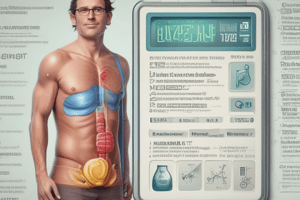Podcast
Questions and Answers
What is a potential long-term consequence of untreated Type 2 Diabetes Mellitus?
What is a potential long-term consequence of untreated Type 2 Diabetes Mellitus?
- Non-ketotic hyperosmolar state (correct)
- Ketonuria
- Fatigue and sleep apnea
- Thyroid dysfunction
Which symptom is NOT commonly associated with diabetes mellitus?
Which symptom is NOT commonly associated with diabetes mellitus?
- Polydipsia
- Polyuria
- Polycythemia (correct)
- Polyphagia
What primarily characterizes Type 1 Diabetes Mellitus?
What primarily characterizes Type 1 Diabetes Mellitus?
- It predominantly occurs in adults.
- There is usually no presence of auto antibodies.
- Insulin resistance is present.
- The pancreas does not produce enough insulin. (correct)
Which test is NOT typically used for diagnosing Diabetes Mellitus?
Which test is NOT typically used for diagnosing Diabetes Mellitus?
What effect does acanthosis nigricans have on the body?
What effect does acanthosis nigricans have on the body?
What characterizes gestational diabetes mellitus?
What characterizes gestational diabetes mellitus?
Which of the following is a risk factor for Type 2 Diabetes Mellitus?
Which of the following is a risk factor for Type 2 Diabetes Mellitus?
Which condition could develop due to diabetes-related complications?
Which condition could develop due to diabetes-related complications?
Which method is considered the gold standard for the detection of glucose?
Which method is considered the gold standard for the detection of glucose?
What is the role of mutarotase enzyme in glucose testing?
What is the role of mutarotase enzyme in glucose testing?
What does a normal HbA1c level range from?
What does a normal HbA1c level range from?
In a ketone test, what does a purple color reaction indicate?
In a ketone test, what does a purple color reaction indicate?
What is the normal reference range for the C-peptide test?
What is the normal reference range for the C-peptide test?
What hormone is primarily involved in increasing glucose levels in response to hypoglycemia?
What hormone is primarily involved in increasing glucose levels in response to hypoglycemia?
Which condition is characterized by impaired receptor binding and usually occurs in neonates?
Which condition is characterized by impaired receptor binding and usually occurs in neonates?
What does the Oral Glucose Tolerance Test (OGTT) involve?
What does the Oral Glucose Tolerance Test (OGTT) involve?
What is considered a capillary blood glucose level above normal?
What is considered a capillary blood glucose level above normal?
Which method is considered the method of choice for measuring glucose due to its higher specificity?
Which method is considered the method of choice for measuring glucose due to its higher specificity?
What is the primary function of hormones produced by the exocrine pancreas?
What is the primary function of hormones produced by the exocrine pancreas?
What does the glucose challenge test (GCT) utilize for its screening purpose?
What does the glucose challenge test (GCT) utilize for its screening purpose?
In the alkaline copper reduction method, which reagent gives a blue color?
In the alkaline copper reduction method, which reagent gives a blue color?
Flashcards are hidden until you start studying
Study Notes
Diabetes Mellitus Overview
- Chronic condition characterized by insufficient insulin production from the pancreas.
- Results in hyperglycemia, which is a high level of glucose in the blood.
- Hypoglycemia indicates low blood sugar levels.
Type 1 Diabetes Mellitus (DM)
- Also known as insulin-dependent, juvenile, or childhood onset diabetes.
- Usually diagnosed around 9 years of age; symptoms include thirst and weight loss.
- Represents 0-15% of the total population.
- Involves destruction of beta cells in the pancreas that produce insulin, leading to lack of glucose entry into cells.
- Ketones are produced as a last energy source due to beta cell destruction.
Immune Response in Type 1 DM
- Autoantibodies target and destroy insulin-producing beta cells.
- Presence of ketonuria indicates fat metabolism resulting from low insulin.
Type 2 Diabetes Mellitus (DM)
- Characterized by insulin resistance; glucose is present but not effectively used by the body.
- No ketonuria typically observed.
- Often develops in adults and is linked to obesity, genetic factors, lack of exercise, and conditions like PCOS.
- Represents about 80% of the diabetic population.
- Beta cells may be present but their function declines, potentially leading to kidney failure if untreated.
Pathophysiology of DM
- Both type 1 and type 2 diabetes result in hyperglycemia.
- Untreated type 2 diabetes can lead to non-ketotic hyperosmolar state and dehydration due to excessive glucose production.
Symptoms and Diagnostic Criteria
- Common symptoms include:
- Polydipsia (increased thirst)
- Polyphagia (increased hunger)
- Polyuria (increased urination)
- Diagnostic tests include:
- HbA1c (glycosylated hemoglobin), which monitors long-term glucose levels.
- Fasting blood sugar, Oral Glucose Tolerance Test (OGTT), and random plasma glucose levels.
Pre-Diabetes Indicators
- Acanthosis nigricans (darkening of skin) can signal pre-diabetes.
- Individuals over 45 years old should be tested for diabetes every 3-6 months.
Gestational Diabetes Mellitus (GDM)
- Glucose intolerance occurring during pregnancy.
- Diagnosed using OGTT; caused by metabolic hormonal changes associated with pregnancy.
- Risks for babies include being overweight, hypoglycemia, and jaundice.
- Mothers may face premature births and increased risk for type 2 diabetes post-pregnancy.
Specific Causes of Diabetes Mellitus
- Genetic defects such as Maturity Onset Diabetes of the Young (MODY) have a strong familial correlation.
- Other causes include diseases affecting the exocrine pancreas and endocrinopathies like Cushing's disease.
- Drug or chemical induced DM often involves hypoglycemic episodes.
Blood Sugar Monitoring and Testing Protocol
- Fasting periods vary: typically 8-10 hours for blood tests.
- Capillary blood glucose > 140 mg/dl indicates potential diabetes.
- OGTT involves drinking glucola and testing blood within a set timeframe after consumption.
Diagnostic Methods for Diabetes
- Various enzymatic and oxidation methods are used for glucose measurement, including:
- Glucose oxidase
- Hexokinase (gold standard)
- HbA1c testing requires EDTA-venous whole blood; its formation is proportional to plasma glucose levels.
- High-Pressure Liquid Chromatography (HPLC) is the gold standard for HbA1c detection.
Testing Parameters and Ranges
- Fast Blood Sugar (FBS) levels < 126 mg/dl indicate normal.
- OGTT < 200 mg/dl and random plasma glucose < 200 mg/dl are considered normal.
- HbA1c levels:
- Normal: 4.2-6.2%
- Pre-diabetes: 5.7-6.4%
- Diabetes: > 6.5%
- Fructosamine normal range is 205-285 mm/l.
Ketone Testing
- Ketone bodies indicate fat metabolism during energy deficiency.
- Tests for acetoacetate and β-hydroxybutyrate utilize fresh serum or urine samples.
Observable Signs of Hypoglycemia
- Symptoms manifest when blood glucose levels drop to 50-55 mg/dl; treatment may require rapid glucose administration.
Studying That Suits You
Use AI to generate personalized quizzes and flashcards to suit your learning preferences.




